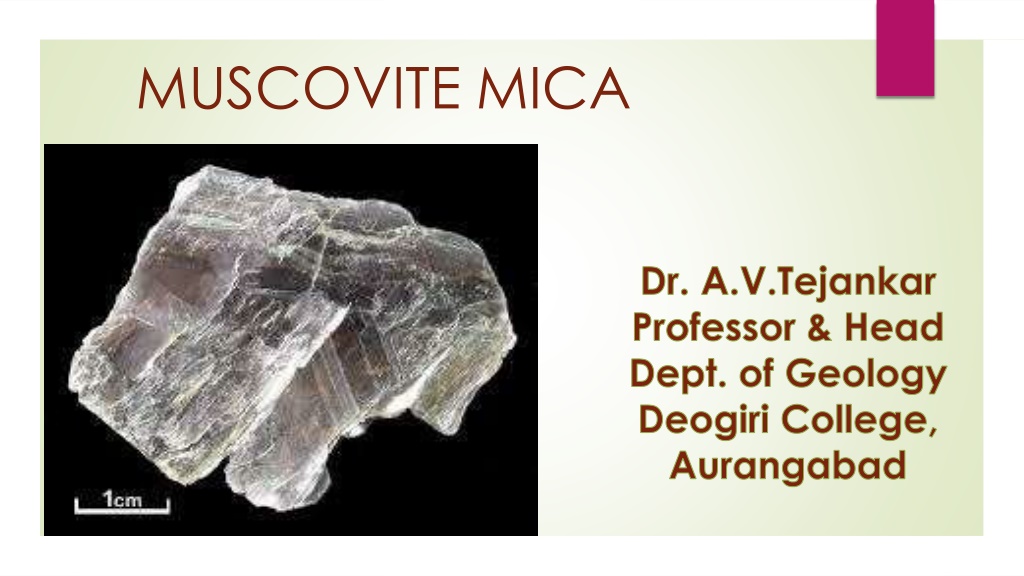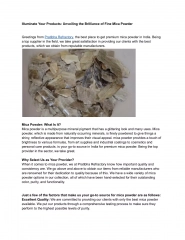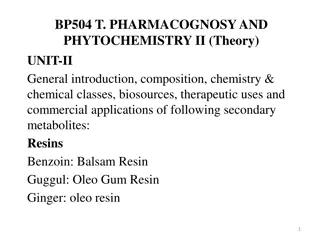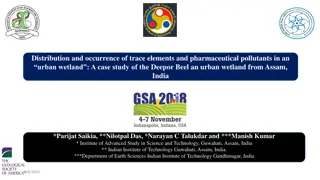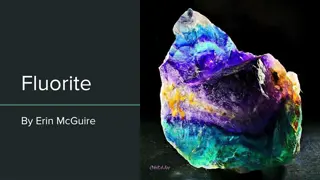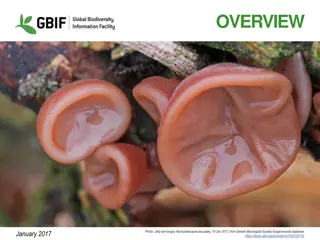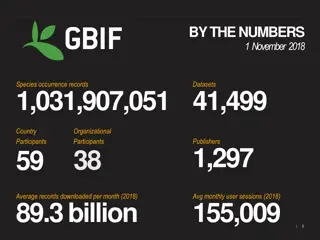Muscovite Mica: Types, Occurrence, and Exploration
Muscovite mica, a mineral with versatile industrial applications, is explored in detail through its types, occurrence in nature, and methods of exploitation. Muscovite, along with Phlogopite, forms the main classes of commercially significant micas, primarily used in various industries worldwide. With color variations and specific characteristics, muscovite mica deposits are mainly found in states like Jharkhand, Rajasthan, and Andhra Pradesh, where systematic mining operations are successfully conducted.
Download Presentation

Please find below an Image/Link to download the presentation.
The content on the website is provided AS IS for your information and personal use only. It may not be sold, licensed, or shared on other websites without obtaining consent from the author.If you encounter any issues during the download, it is possible that the publisher has removed the file from their server.
You are allowed to download the files provided on this website for personal or commercial use, subject to the condition that they are used lawfully. All files are the property of their respective owners.
The content on the website is provided AS IS for your information and personal use only. It may not be sold, licensed, or shared on other websites without obtaining consent from the author.
E N D
Presentation Transcript
MUSCOVITE MICA Dr. A.V.Tejankar Professor & Head Dept. of Geology Deogiri College, Aurangabad
What is Mica? Mica is a generic term applied to a group of rock- forming complex aluminosilicate minerals having a sheet or plate like structure with varying chemical composition and physical properties.
Types Of Mica Of the nine common varieties in the mica group of minerals, the two principal classes of Mica types of commercial importanceare Muscovite : K Al2 (Al Si3 O10 )(OH) 2and Phlogopite : K Mg3 (Al Si3 O10 )(OH)2
Muscovite Mica It is a hydrous potassium aluminium silicate with a predominance of potassium. It ranges from colourless through browns to greens or reds.
PhlogopiteMica It is a hydrous magnesium aluminium silicate with a predominance of magnesium. It iscommonly called as Amber Mica which varies in colour from light silver to dark brown or amber.
Occurence Muscovite is the most common mica, found in Granites, Pegmatites, Gneisses, and Schists, and as a contact metamorphic rock or as a secondary mineral resulting from the alteration of Topaz, Feldspar, Kyanite, etc. In Pegmatites, it is often found in immense sheets that are commercially valuable.
Exploration and exploitation is successfully carried by means of systematic vertical shaft and open cast mining. The principal muscovite mica deposits are chiefly found in the States of Jharkhand, Rajasthan and Andhra Pradesh. Jharkhand (formerly Bihar State) which produces the world's finest muscovite mica well known throughout the globe
Muscovite Mica may be divided into two color groups : RUBY MUSCOVITE GREEN MUSCOVITE
RubyMuscovite Colour ranges from an almost white through pink to a light ruby and into shades of brownish ruby and brown. It is produced in the Indian States of Jharkhand and Rajasthan.
Green Muscovite Ranges from light to pale green through yellowish and olive green to a dark green. It is produced in the Indian State of Andhra Pradesh.
Physical Properties Lustre -Vitreous, Silky, Pearly Diaphaneity (Transparency):Transparen t, Translucent
Cleavage:Perfect Perfect on {001}. Fracture:Micaceous Crystal System: Monoclinic with a = 5.199 , b = 9.027 , c = 20.106 =95.78
DISTINGUISHING SIMILAR MINERALS Chloriteand Margarite - Not as elastic as Muscovite. Biotite, Phlogopite - Usually darker in color, otherwise very difficult to distinguish. Lepidolite - Very difficult to distinguish from pink Muscovite. Gypsum - Cannot be peeled into micaceous sheets, crystals usually differently shaped.
